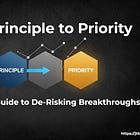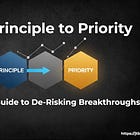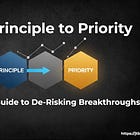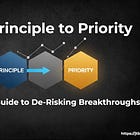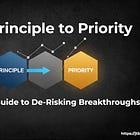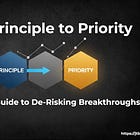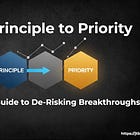From Principle to Priority: A Systematic Guide to De-Risking Breakthroughs
Chapter 1: The Monolithic Fallacy: Why Traditional Innovation Fails
This 10-article series is designed to disrupt common thinking about innovation. It provides a new framework to help you tear down old methods and invest more efficiently in breakthrough ideas. Please share!
Part 1: The Case for a New Playbook
It is one of the most familiar rituals of the modern corporation. A team of bright, ambitious innovators, having toiled for months in secrecy, stands before a committee of executives. The room is dim, the coffee is stale, and the air is thick with the competing tensions of hope and skeptical scrutiny. On the main screen glows the centerpiece of the ritual: the hockey-stick graph.
This is the moment of the “big ask.” The team is presenting its monolithic business case, a dense, feature-rich document that culminates in a five-year forecast of revenues, costs, market share, and, ultimately, a single, talismanic number: the Return on Investment (ROI).
Everyone in the room, from the presenters to the executives, understands this ritual is a charade.
The presenters, in order to even secure this meeting, have been forced to engage in a peculiar form of financial astrology. They have been asked to predict, with decimal-point precision, the customer acquisition cost for a product that does not exist, in a market that may not know it has a problem. They have fabricated a number for the “total addressable market” by chaining together a series of optimistic and indefensible assumptions. They have, in short, been forced to write a work of fiction—a compelling, data-drenched story of a certain future—all to satisfy a process that demands knowability where none exists.
The executives, for their part, play their role. They nod along, dutifully probing the assumptions. “Can you really achieve a 3% conversion rate in Year 2?” one might ask, knowing full well the number is pure conjecture. “How confident are we in this $500 million market size?” another might parry. This isn’t a search for truth. It is a test of plausibility. The committee is not evaluating a real-world venture; it is judging the team’s ability to construct a convincing and internally consistent fantasy.
This is the illusion of certainty. And it is the single greatest killer of innovation inside established organizations.
This process is not without consequence. The monolithic business case, with its demand for a single, binary, up-or-down vote on a massive, multi-year budget, creates a filter that systematically destroys the very thing it purports to fund.
When a committee is faced with two proposals, what happens?
The first proposal is a true breakthrough. It’s a high-uncertainty, high-potential idea. When pressed for a five-year forecast, the team leader—if honest—would have to say, “We don’t know. We don’t know the market, the cost, the customer, or if the technology will even work. But we have a powerful hypothesis, and if we’re right, it changes the entire business.” This proposal is deemed “too risky.” Its spreadsheet is full of holes, its numbers based on “what-ifs” rather than “what-is.”
The second proposal is a safe, incremental improvement. It’s a 10% cost reduction on an existing manufacturing line. It’s a new, minor feature for a mature software product. This team’s spreadsheets are magnificent. They are grounded in years of historical data. The costs are known, the market is defined, and the ROI, while modest, is highly predictable. This proposal is “a smart, data-driven bet.”
The committee, charged with being responsible stewards of shareholder capital, funds the second proposal. The first is sent back “for more data,” a polite euphemism for a quiet death.
The result is a portfolio of incrementalism. The organization, while publicly championing “radical disruption,” finds itself incapable of funding anything but the safest, most obvious, and least impactful ideas. It optimizes its way to irrelevance, all while congratulating itself on its financial prudence. The monolithic business case acts as a powerful, systemic immune response, identifying and neutralizing high-potential (but uncertain) ventures like a foreign virus.
The core problem, the fundamental error in this entire model, is that we are treating exploration as if it were execution.
We have confused two fundamentally different modes of business.
Execution is about minimizing variance. When you are building a factory, optimizing a supply chain, or managing a mature product line, the variables are known. The goal is to do what you already know how to do, but more efficiently. You have a plan, and success is defined by your ability to follow that plan on time and on budget. A traditional, predictive ROI model is perfectly suited for this.
Exploration, however, is about maximizing learning. When you are searching for a new business model, testing a novel technology, or trying to solve a customer problem that has never been solved, the variables are unknown. A plan is a liability. Success is not defined by adherence to a spreadsheet, but by the speed at which you can invalidate bad assumptions and discover a path that works.
The goal is not to be right in your initial prediction; the goal is to pay the least to learn the most.
Applying the tools of execution to the work of exploration is like trying to navigate an uncharted ocean with a railroad map. It is not just ineffective; it is actively destructive. It forces teams to lie, punishes honesty, and guarantees that the only ideas that survive the funding process are the ones that are too small to matter.
This is the Monolithic Fallacy. And to de-risk innovation, we must first dismantle it. We must replace this single, high-stakes gamble with a new system—one that embraces uncertainty and treats innovation not as a one-time bet, but as a staged, systematic, and entirely rational process of buying information. We need an alternative.
Guide to the Series
I make content like this for a reason. It’s not just to predict the future; it’s to show you how to think about it from first principles. The concepts in this blueprint are hypotheses—powerful starting points. But in the real world, I work with my clients to de-risk this process, turning big ideas into capital-efficient investment decisions, every single time.
Follow me on 𝕏: https://x.com/mikeboysen
If you’re interested in inventing the future as opposed to fiddling around the edges, feel free to contact me. My availability is limited.
Mike Boysen - www.pjtbd.com
De-Risk Your Next Big Idea
Masterclass: Heavily Discounted $67
My Blog: https://jtbd.one
Book an appointment: https://pjtbd.com/book-mike
Join our community: https://pjtbd.com/join



